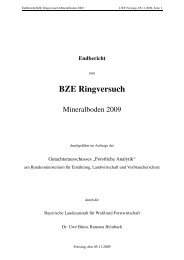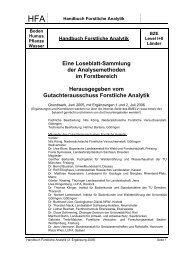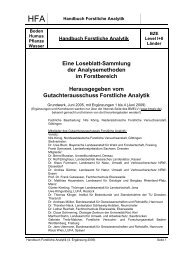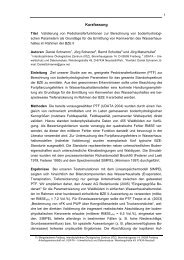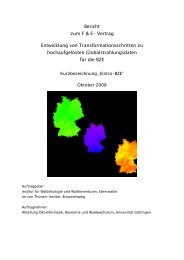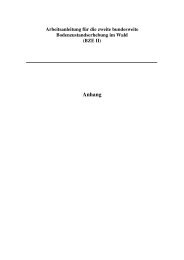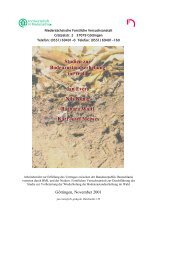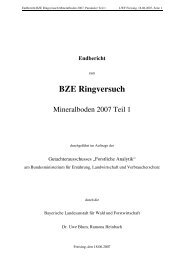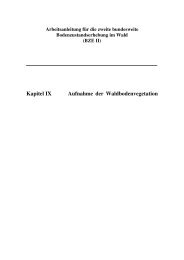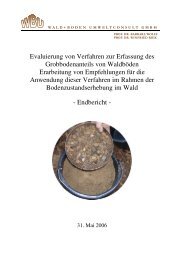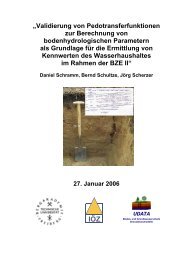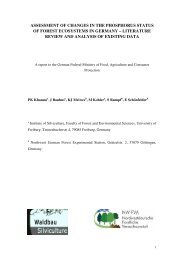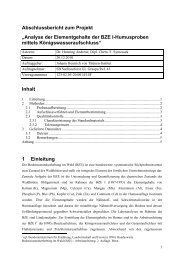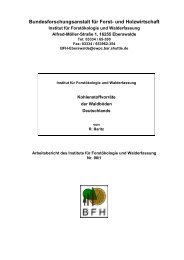assessment of changes in the phosphorus status of forest ...
assessment of changes in the phosphorus status of forest ...
assessment of changes in the phosphorus status of forest ...
Create successful ePaper yourself
Turn your PDF publications into a flip-book with our unique Google optimized e-Paper software.
example <strong>the</strong> compiled data from BZE-I sites for spruce showed that 3-year old spruce<br />
needles had 30 to 40 % lower values <strong>of</strong> P than <strong>the</strong> fully developed needles from <strong>the</strong><br />
current year (Fig 1). The difference between 1 st - and 3 rd year needles were<br />
surpris<strong>in</strong>gly constant across <strong>the</strong> whole range <strong>of</strong> needle P concentrations <strong>in</strong> spruce<br />
(BMLEF 1997). In ano<strong>the</strong>r data set shown <strong>in</strong> Table 5, foliar P levels <strong>in</strong> ten spruce<br />
stands were measured cont<strong>in</strong>uously for 10 years. Three years old needles had 66 to 82<br />
% <strong>of</strong> P present <strong>in</strong> <strong>the</strong> one year old needles. Five year old needles had fur<strong>the</strong>r reduced<br />
P levels (range 47% to 70%). The amount <strong>of</strong> P re-allocated from 5 year old needles to<br />
<strong>the</strong> youngest cohort <strong>of</strong> needles equated to 30 to 50 % <strong>of</strong> <strong>the</strong> content <strong>in</strong> <strong>the</strong> current year<br />
needles. The withdrawal was not related to any measured site property. Similar results<br />
were also obta<strong>in</strong>ed for one and two years old needles <strong>of</strong> Scots p<strong>in</strong>e.<br />
Soil characteristics<br />
In a study <strong>of</strong> 49 stands <strong>of</strong> European beech (60-or more years-old) <strong>in</strong> <strong>the</strong> Werdenfelser<br />
Land region where <strong>the</strong> canopy conditions were monitored, Ewald (2000) analysed<br />
foliage and soil samples from 8 sites for nutrient composition. Sites could be divided<br />
<strong>in</strong>to 2 groups. Moderate P levels were found <strong>in</strong> trees from well-developed m<strong>in</strong>eral<br />
soils, and extremely low P levels (0.6-1.0 mg/g) <strong>in</strong> immature carbonate soils where<br />
total P levels <strong>in</strong> soils were low and Ca saturation very high. Very high N/P ratios <strong>of</strong><br />
30 or more were associated with low P levels. Phosphorus was a critical element <strong>in</strong><br />
<strong>the</strong> nutrition <strong>of</strong> beech <strong>in</strong> <strong>the</strong> calcareous Alps, which may be partly responsible for<br />
poor vitality <strong>of</strong> this species <strong>in</strong> mixed mounta<strong>in</strong> <strong>forest</strong>s. Foliar P values <strong>in</strong> beech <strong>forest</strong>s<br />
on calcareous bedrocks are commonly low when compared to acid soils. As <strong>the</strong><br />
availability <strong>of</strong> protons is required to release P from rock m<strong>in</strong>erals it is possible that<br />
low foliar P values on calcareous bedrock may result from <strong>the</strong> high buffer<strong>in</strong>g <strong>of</strong> most<br />
<strong>of</strong> <strong>the</strong> protons by carbonates which renders less protons available for silicate<br />
wea<strong>the</strong>r<strong>in</strong>g.<br />
Highest values <strong>of</strong> foliar P are found <strong>in</strong> spruce and p<strong>in</strong>e stands on bedrocks <strong>of</strong> basalt<br />
type (bedrock type 8 – median value <strong>of</strong> P <strong>in</strong> <strong>the</strong> current needles <strong>of</strong> 1.5 mg P/g) and <strong>the</strong><br />
lowest on <strong>the</strong> calcareous type (bedrock type 1 – median values were 1.2 mg/g for<br />
spruce and 1.3 mg/g for p<strong>in</strong>e (BMELF 1997).<br />
25



